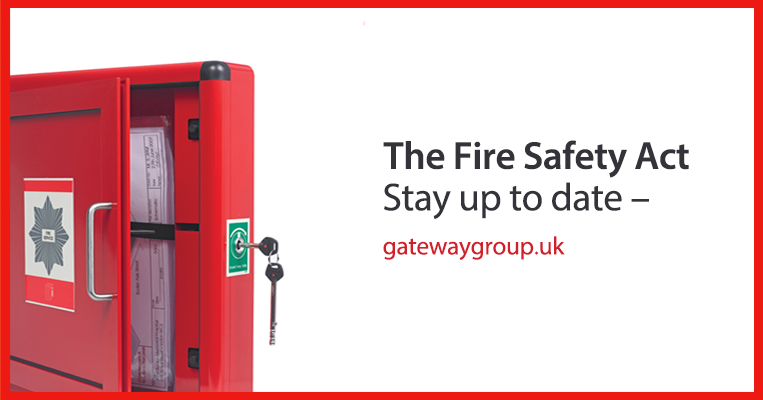The Fire Safety Act 2021 and Fire Safety (England) Regulations 2022: Everything you need to know
Published on 21st December 2022

The Fire Safety Act 2021 and Fire Safety (England) Regulations 2022 has been introduced as an important step towards implementing the recommendations of the Grenfell Tower Inquiry Phase 1 report. The Regulations are being introduced under Article 24 of the Fire Safety Order.
The Act clarifies that responsible persons for multi-occupied residential buildings must manage and reduce the risk of fire for the structure and external walls of the building, including cladding, balconies and windows, and entrance doors to individual flats that open into common parts.
These new regulations introduce additional requirements on responsible persons, aimed at identifying and communicating fire risk information to those who need to know about the risk. This includes providing fire risk information regarding evacuation procedures to residents in a format they will understand.
Here’s everything you need to know about The Fire Safety Act 2021 and Fire Safety (England) Regulations 2022.
What does the Fire Safety Act do?
The Act clarifies that where a building contains 2 or more sets of domestic premises, the Fire Safety Order applies to:
- the building’s structure and external walls (including windows, balconies, cladding, insulation and fixings) and any common parts
- all doors between domestic premises and common parts such as flat entrance doors (or any other relevant door)
The Act provides greater clarity on where the Fire Safety Order applies in multi-occupied residential buildings. Responsible persons must manage and reduce the risk of fire for:
- the structure and external walls of the building, including anything attached to the exterior of those walls, such as cladding, balconies and windows; and
- entrance doors to individual flats that open into common parts.
Why were these changes introduced?
Following the devastating Grenfell Tower Fire in 2017, the Grenfell Tower Inquiry was established. To meet the Inquiry’s Phase 1 recommendations, the Fire Safety (England) Regulations 2022 (the Regulations) were introduced.
Which parts of the UK do these changes apply to?
The Act applies to England and Wales. However, the Regulations only apply to England.
What do the Fire Safety (England) regulations require responsible persons to do?
Most of the requirements set out in the Regulations are imposed on the responsible person, which means they need to plan and prepare for ahead of the Regulations coming into force.
The regulations require responsible persons in multi-occupied residential buildings to take specific actions, depending on the height of the building:
- some provisions apply regardless of height
- more are needed once a building reaches 11 metres, and
- further requirements are introduced when a building reaches 18 metres (or 7 storeys) or more.
The Regulations set out requirements for responsible persons of all multi-occupied residential buildings, of two or more sets of domestic premises:
- Fire Safety Instructions: they must provide relevant fire safety instructions to their residents on how to report a fire and what a resident must do once a fire has occurred.
- Fire Door Information: provide residents with information relating to the importance of fire doors in fire safety.
The Regulations also set out requirements for responsible persons of multi-occupied residential buildings of over 11 metres in height:
- Annual and quarterly checks fire door: They must undertake best endeavors to carry out annual checks of flat entrance doors. They must undertake quarterly checks of all fire doors in the common parts.
The Regulations for high-rise residential buildings (at least 18m or 7 storeys in height) also require responsible persons to:
- Building Plans: provide their local FRS with up-to-date building floor plans by electronic means and to place a hard copy of these plans, alongside a single page building plan which identifies key firefighting equipment, in a secure information box on site.
- External Wall Systems: provide to their local FRS information about the design and materials of a high-rise building’s external wall system and to inform the FRS of any material changes to these walls. Also, they will be required to provide information in relation to the level of risk that the design and materials of the external wall structure gives rise to and any mitigating steps taken.
- Lifts and other Key Fire-Fighting Equipment: undertake monthly checks on the operation of lifts intended for use by firefighters, and evacuation lifts in their building and check the functionality of other key pieces of firefighting equipment. They will also be required to report any defective lifts or equipment to their local FRS as soon as possible after detection if the fault cannot be fixed within 24 hours, and to record the outcome of checks and make them available to residents.
- Secure Information Boxes: install and maintain a secure information box in their building. This box must contain the name and contact details of the responsible person
and hard copies of the building floor plans. - Wayfinding Signage: install signage visible in low light or smoky conditions that identifies flat and floor numbers in the stairwells of relevant buildings.
When will the changes take effect?
The Fire Safety (England) Regulations 2022 will come into force on 23rd January 2023.
Where can I find out more information?
You can find out more by visiting the NFCC website.
